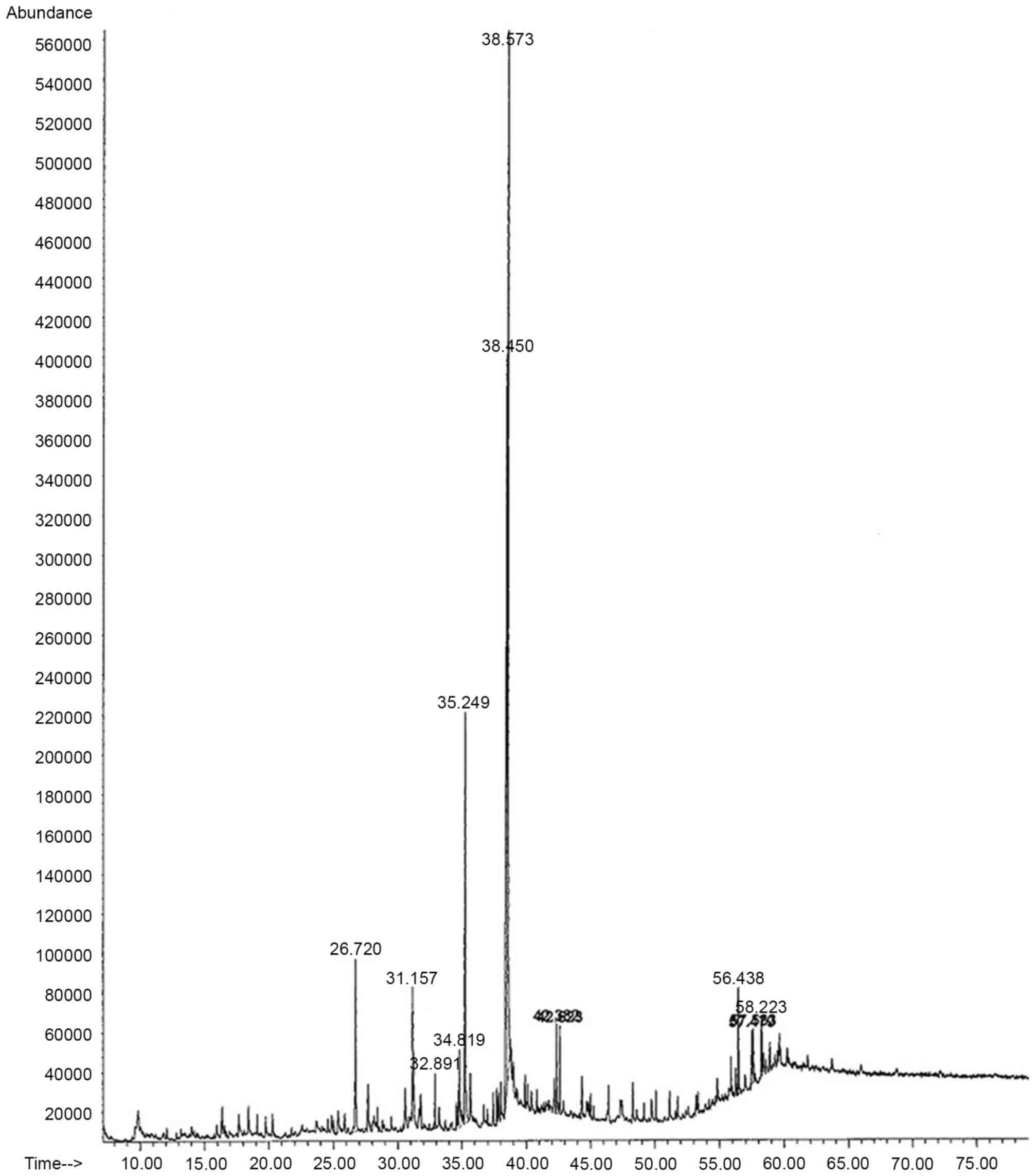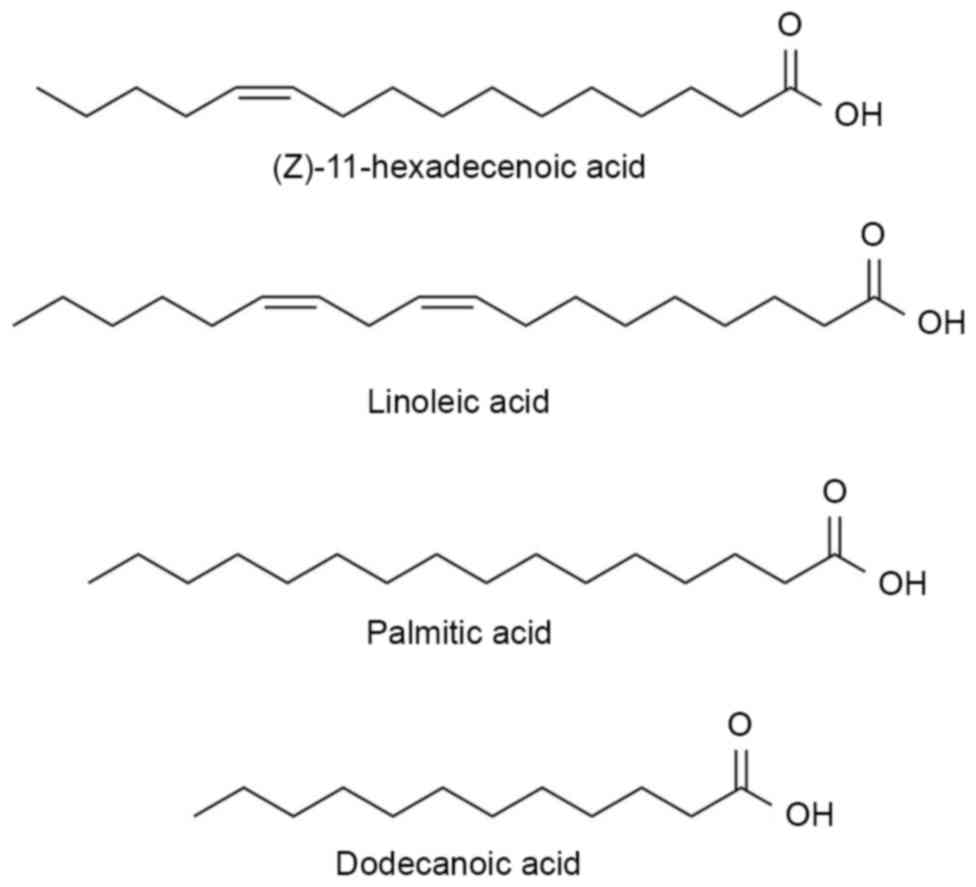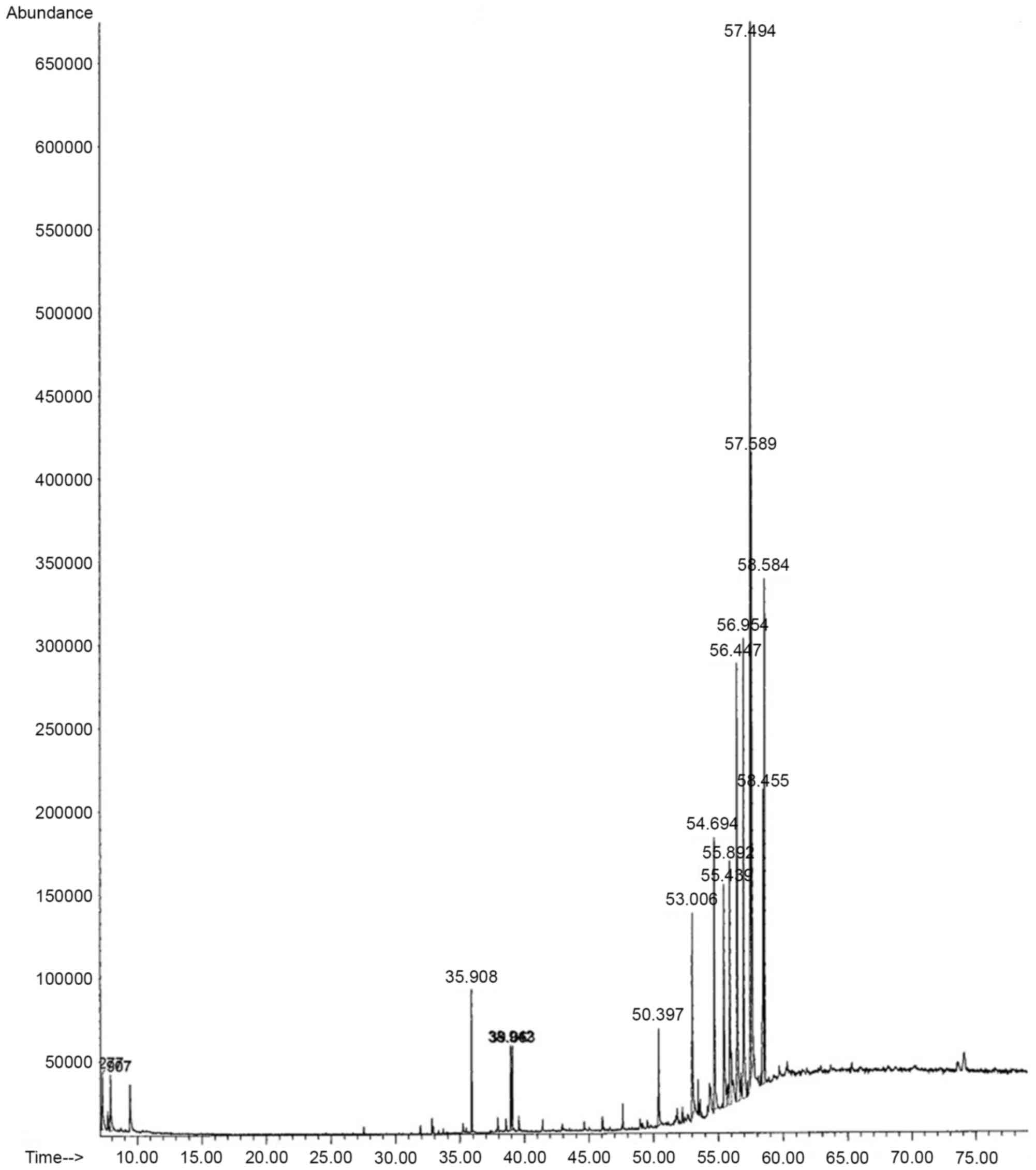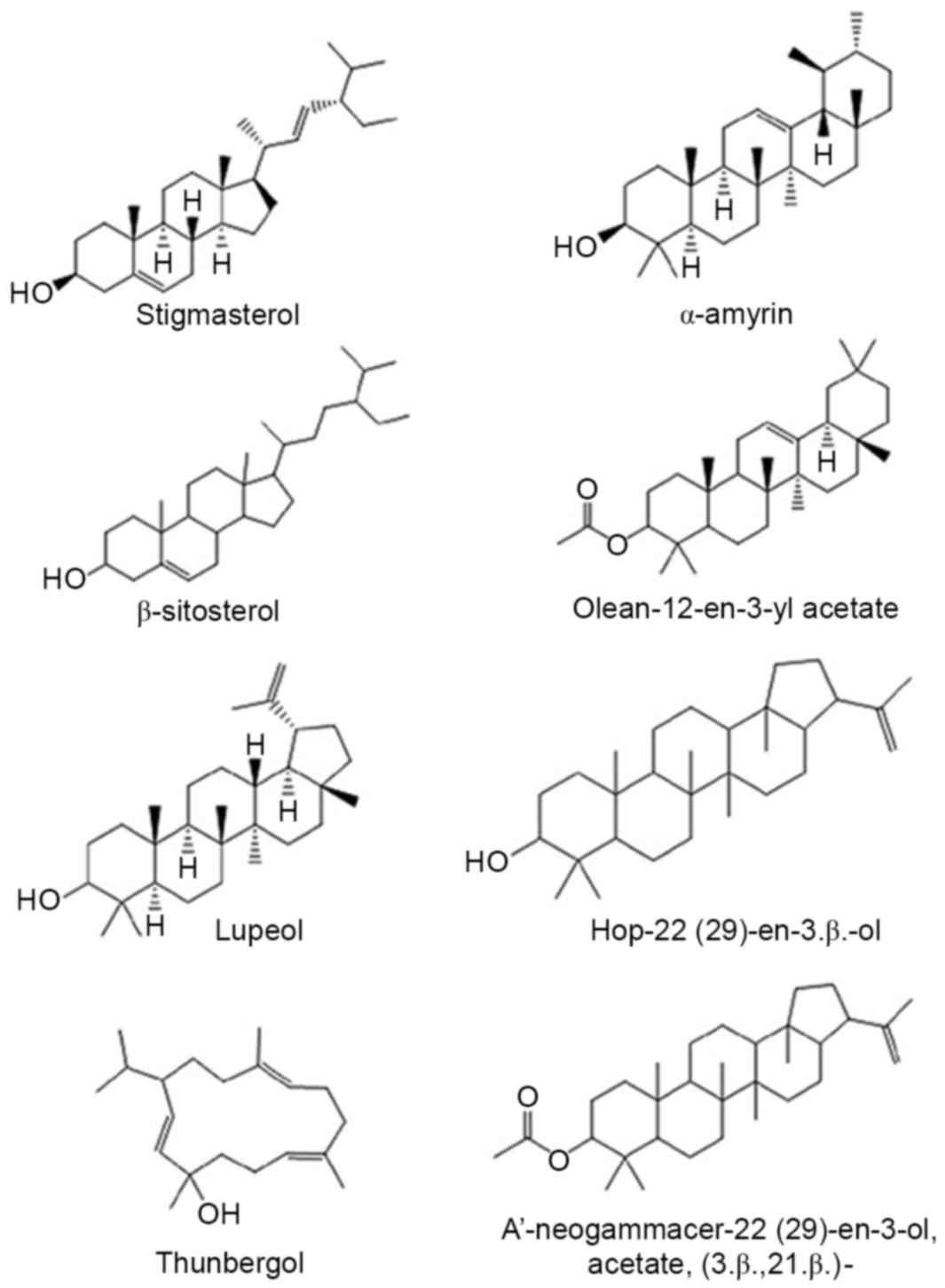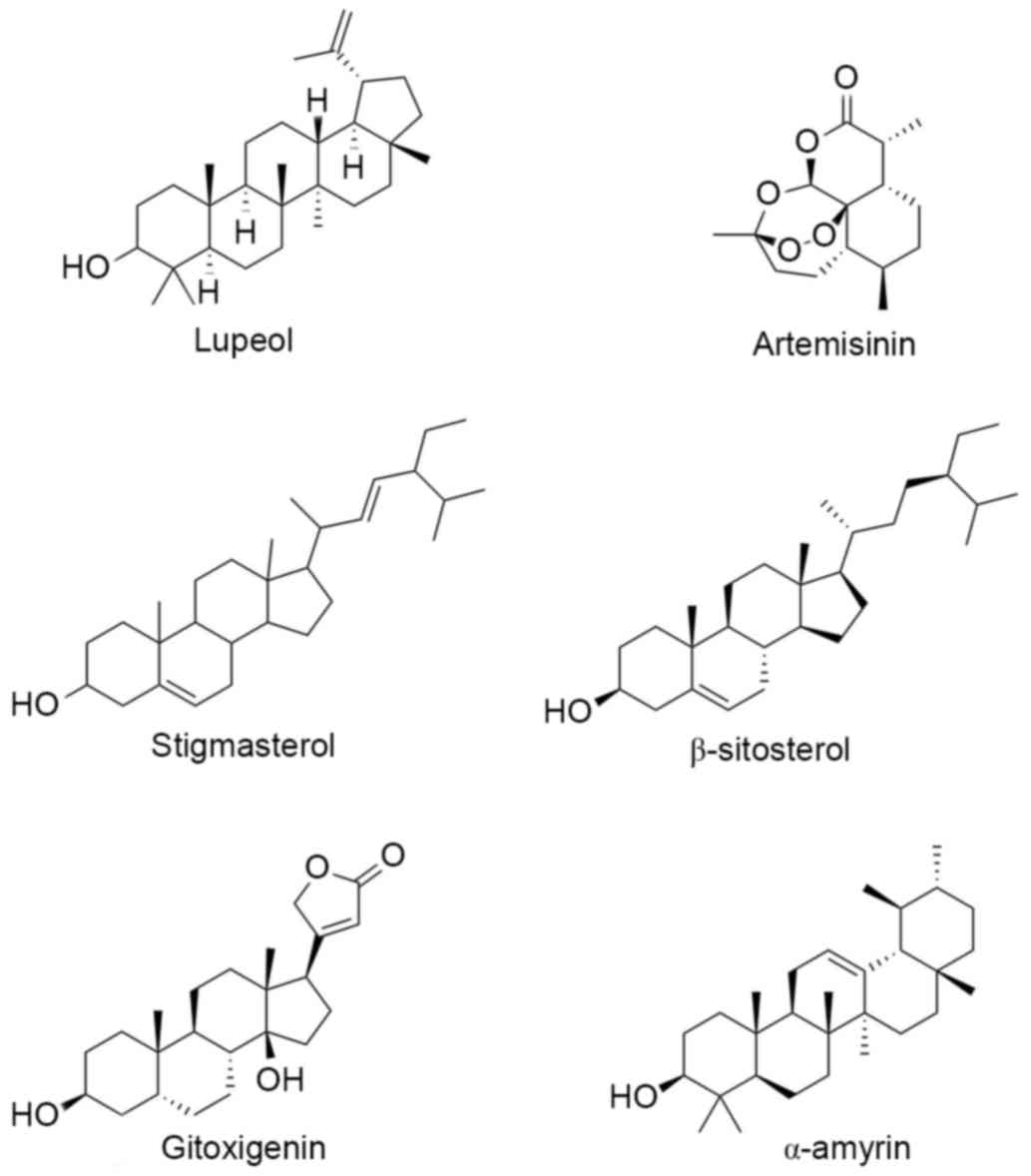Introduction
Gundelia tournefortii (Asteraceae) thistle is
a vegetable that is similar to artichoke and grows in the
semi-desert climate of numerous countries in the Mediterranean
region (1). Particularly in
Palestine, G. tournefortii, or ‘Akoob’ in Arabic, remains
uncultivated, harvested by local populations, and is considered
highly valuable due to its reputed health benefits (2). Previously, it was listed as 1 of the 10
species with the highest mean cultural importance in northern
Palestine (2), and it is a component
of a number of traditional recipes, which differ according to
different localities. In Palestinian traditional medicine and
ethno-botany, this plant is believed to possess nutritive and
curing benefits for diabetes, epilepsy, stomach and intestinal
diseases (3,4). According to the literature, it has been
validated to exert antioxidant, hepatoprotective and antibacterial
effects (1,5). A previous study (2) conducted among Palestinians eating Akoob
on a regular basis revealed a consensus belief of its capability to
prevent and cure cancer. However, an intensive search of PubMed
(using the terms gundelia tournefortii and cancer; on 12th
September 2016) indicates that there is no single study on the
effects of G. tournefortii extracts against cancer. The
present study aimed to investigate the anticancer effects of G.
tournefortii on the human colon cancer HCT-116 cell line. Gas
chromatography-mass spectrometry (GC-MS) was utilized to explore
the potential phytochemicals responsible for the anticancer
activity. A total of 27 constituents were identified in G.
tournefortii, of which 6 phytochemicals, including sitosterol,
stigmasterol, lupeol, gitoxigenin, α-amyrin and artemisinin have
been demonstrated to exhibit anticancer activities. To the best of
our knowledge, the present study was the first to investigate the
potential benefits of consuming wild edible G. tournefortii
for cancer, and to analyze the phytochemical contents known for
their anticancer effects.
Materials and methods
Plant material
The G. tournefortii plant was collected from
the mountains of Nablus in northern Palestine between February and
March 2014. The prickles were removed with scissors, and the stems
and head sections (the parts of the plant that are usually
consumed) were reserved. The processed plant was dried in the shade
at room temperature.
Extract preparation
The air-dried aerial parts of G. tournefortii
were ground into a fine powder using mixer grinder machine. Three
equal fractions, weighing 25±0.01 g, of the ground plant were then
transferred into Erlenmeyer flasks, and treated with 250 ml
methanol (MeOH of purity >99.9%), H2O or hexane
(C6H14, 99% purity) solvents separately. The
flasks were then sonicated for 2 h at 50°C, and left in glass
bottles (covered with aluminum foil) in the dark for 24 h to ensure
complete extraction of the compounds. The extracts were filtered by
passing the solvents through a 0.4-µm filter. A total of 10 ml was
removed from each solvent type for analysis of antioxidant
activity. The remaining volume from each solvent type was
evaporated under reduced pressure (range, 0.05 and 0.2 atm) and
dissolved in dimethyl sulfoxide for in vitro experiments.
The yields of the extracts were calculated by dividing the weight
of the extracted material following vacuum evaporation on the crude
material and found to be 3.2, 1.8 and 12% (wt/wt) for the methanol,
hexane and water extracts, respectively. The stock crude extracts
were preserved in sealed glass containers and kept at −20°C until
use.
MTT assay
MTT is a water-soluble tetrazolium salt, which is
converted to insoluble purple formazan by cleavage of the
tetrazolium ring by succinate dehydrogenase within the
mitochondria. The formazan product accumulates only in healthy
cells. The assay was optimized for the cell lines used in the
experiments. MTT was applied to assess cell viability as described
in a previous study (6). HCT-116
(colorectal carcinoma cell-line from the American Type Culture
Collection termed in brief ATCC® CCL247™) cells
(2×104/well) were plated in 200 µl medium/well in
96-well plates and were allowed to adhere to the plate for 24 h.
The medium was purchased from Biological Industries Israel Beit
Haemek Ltd, Kibbutz Beit Haemek, Israel. Plant extracts were added
at increasing concentrations (0–1,000 µg/ml) for 22 h. The cell
medium was then replaced with 100 µl fresh medium/well containing
0.5 mg/ml MTT and cultivated with the cells for an additional 4 h
in an incubator in the dark at 38°C. The supernatant was removed
and 100 µl isopropanol/HCl [2% HCl (0.1 M) in isopropanol] was
added to each well. The absorbance at 620 nm (A620) was
measured with microtiter plate reader (Anthos Labtec Instruments,
Austria). For each plate, two wells without cells served as blanks.
All experiments were repeated three times in triplicate. The
effects of the plant extracts on cell viability were expressed
using the following formula: Percent viability = (A620
of treated sample / A620 of non-treated sample)
×100.
GC-MS analysis
Solutions of the G. tournefortii methanol and
hexane extracts were selected and examined with GC-MS using an
Agilent 7890A GC system coupled with the Agilent 5975C inert MSD
with Triple-Axis Detector mass spectrometer (Agilent Technologies,
Inc., Santa Clara, CA, USA). The GC was performed on an Agilent
J&W GC HP-5 column [30 m × 0.32 mm (inner diameter), with
0.25-µm film thickness; Agilent Technologies, Inc., Santa Clara,
CA, USA]. The carrier gas was helium at a flow rate of 1.2 ml/min,
and the injection volume was 1 µl. The injection port and the MS
interface temperatures were 300°C and the ionization voltage was 70
eV. The samples were injected in the split mode with a ratio of
10:1. Mass spectra were recorded every second over a range set at
(m/z) of 45–800 Da. The oven heating stage was activated with an
initial temperature of 50°C for 5 min, then increased to 320°C at a
rate of 5°C/min, and then maintained at 320°C for an additional 20
min. The total duration of the GC-MS protocol was 79 min, and the
solvent delay time was 7 min.
The percentages of the phytochemical components were
computed from the GC peak areas normalization. The normalization is
done automatically by the software while dividing the peak area of
each peak by the total area and multiply by 100. Library searches
were performed using the Mass Spectral Library of the National
Institute of Standards and Technology (Gaithersburg, MD, USA).
Results and Discussion
In vitro anticancer activity of the
different G
tournefortii extracts
The effects of G. tournefortii extracts on
HCT-116 human colon cancer cells were determined using the MTT
assay. The HCT-116 cell line was exposed to G. tournefortii
methanol, hexane and aqueous extracts (0–1,000 µg/ml for 22 h. The
half maximal effective concentrations obtained by the MTT assay
were 303.3±12 µg/ml for the methanol extract and 313.3±18.6 µg/ml
for the hexane extract. However, the aqueous extract only reduced
cell viability to 74.8% at concentration of 1,000 µg/ml, thus
demonstrating inactivity on cancer cells.
Phytochemical analysis of G.
tournefortii using GC-MS
The phytochemical screening using GC-MS in the
electron impact mode revealed 27 compounds in the G.
tournefortii methanol and hexane extracts, 19 of which, to the
best of our knowledge, were detected for the first time in G.
tournefortii (Figs. 1–4), with the remaining 6 components
[including stigmasterol (PubChem CID: 5280794), β-sitosterol
(PubChem CID: 222284), palmitic acid, linoleic acid, α-linolenic
acid and stearic acid] having been identified previously (5). Figs. 1 and
2 indicate the total ion
chromatograms of the hexane and methanol extracts. The analysis of
these two extracts revealed 14 and 13 major components in the
hexane and methanol extracts, respectively (Tables I and II; Figs. 3
and 4). Compounds such as sterols,
triterpenes, esters and carboxylic acids were observed in the G.
tournefortii extracts in large quantities. For example, two
common sterols known as sitosterol and stigmasterol (Fig. 3), were observed in the hexane extract
constituting ~10% of its components (Table I). It has been demonstrated that
sitosterol acts as an inhibitor of tumor promotion in vivo
and that it inhibits carcinogenesis (7,8).
Furthermore, stigmasterol significantly inhibits tumor promotion in
two-stage carcinogenesis in mice (7,9). A mixture
of sitosterol and stigmasterol was indicated to possess
anti-inflammatory activity following topical application (10). Therefore, it is expected that the
presence of such sterols in G. tournefortii may be important
for its anticancer activities.
 | Table I.Phytochemicals of Gundelia
tournefortii from the hexane extract by gas chromatography-mass
spectrometry. |
Table I.
Phytochemicals of Gundelia
tournefortii from the hexane extract by gas chromatography-mass
spectrometry.
| No. | Retention time
(mins) | Component name | Abundance, % |
|---|
| 1 | 35.91 | Methyl palmitate | 1.89 |
| 2 | 38.94 | Methyl linoleate | 1.27 |
| 3 | 39.06 | Ethyl oleate | 1.65 |
| 4 | 50.39 | NI | 1.96 |
| 5 | 53.01 | Heptadecane | 4.21 |
| 6 | 54.69 |
Stigmasterola | 5.75 |
| 7 | 55.44 |
β-sitosterola | 5.09 |
| 8 | 55.89 | α-amyrina | 5.76 |
| 9 | 56.45 | Lupeola | 9.17 |
| 10 | 56.95 | Olean-12-en-3-yl
acetate | 9.58 |
| 11 | 57.49 | Thunbergol | 24.41 |
| 12 | 57.59 |
Hop-22(29)-en-3.β.-ol | 11.31 |
| 13 | 58.45 | NI | 6.58 |
| 14 | 58.58 |
A′-neogammacer-22(29)-en-3-ol, acetate,
(3.β.,21.β.)- | 8.341 |
 | Table II.Phytochemicals of Gundelia
tournefortii from the methanol extract by gas
chromatography-mass spectrometry. |
Table II.
Phytochemicals of Gundelia
tournefortii from the methanol extract by gas
chromatography-mass spectrometry.
| No. | Retention time,
min | Component name | Abundance, % |
|---|
| 1 | 26.72 | Dodecanoic acid | 5.16 |
| 2 | 31.16 | Tetradecanoic
acid | 1.58 |
| 3 | 32.89 |
6,10,14-trimethylpentadecan-2-one | 1.18 |
| 4 | 34.82 | (Z)-11-hexadecenoic
acid | 2.41 |
| 5 | 35.25 | Palmitic acid | 11.70 |
| 6 | 38.45 | Linoleic acid | 26.88 |
| 7 | 38.57 |
(9Z)-9,17-octadecadienal | 39.28 |
| 8 | 42.38 |
Artemisinina | 2.39 |
| 9 | 42.62 | Matricarin | 1.97 |
| 10 | 56.44 |
Hop-22(29)-en-3.β.-ol | 2.81 |
| 11 | 57.48 | NI | 1.53 |
| 12 | 57.58 | NI | 1.59 |
| 13 | 58.22 |
Gitoxigenina | 1.51 |
Lupeol (PubChem CID: 222284; Table I; Fig.
3), an additional phytochemical, which to the best of our
knowledge has never been identified to be present in G.
tournefortii, weighed ~10% of the hexane extract. It has been
revealed to act as a novel androgen receptor, which inhibits the
proliferation of human prostate cancer cells by targeting β-catenin
signaling during carcinogenesis (11).
In addition to the aforementioned 4 anticancer
phytochemicals, gitoxigenin (PubChem CID: 348482; Table II), which weighed ~1.5% of the G.
tournefortii methanol extract, was suggested to elicit
significant anticancer activity (12)
against renal adenocarcinoma and other cancer cell lines, with
half-maximal inhibitory concentration (IC50) values in
the µM range. Furthermore, α-amyrin (PubChem CID: 73170; Table I; Fig.
3), which composed ~5.7% of the hexane extract, was identified
previously to have significant anticancer activity (13) on four cancer cell lines (MCF-7,
BEL-7402, SPC-A-1 and SGC-7901), with IC50 values of
7.2±0.12, 8.2±0.29, 7.6±0.06 and 5.0±0.12 µM, respectively.
The methanol extract contained 6 carboxylic acids,
together representing almost half of the whole extract (48.9%).
Artemisinin (PubChem CID: 68827; Table
II), an active promising photochemical, was also identified for
the first time, to the best of our knowledge, in G.
tournefortii extracts, comprising 2.39%. This compound is
currently undergoing investigation for its use in the treatment of
cancer (14). Additionally,
artemisinin was mentioned in >300 studies as a compound with
potential anticancer activities (PUBMED search using the terms:
Artemisinin AND [anticancer OR cytotoxic], on 21 September
2016).
Summary
To the best of our knowledge, the present study was
the first to highlight the anticancer activity of G.
tournefortii. Methanol and hexane extracts exhibited anticancer
capacities against the HCT-116 cancer cell line, while the aqueous
extract was inactive. Using GC-MS, miscellaneous phytochemicals in
the methanol and hexane extracts were identified. The results
obtained indicate the abundance of important active ingredients in
this plant. The existence of potent chemicals, such as sitosterol,
stigmasterol, lupeol, gitoxigenin, α-amyrin and artemisinin
(Fig. 5) may act additively or
synergistically, and therefore would be important factors in the
preventative and anticancer properties of G. tournefortii.
The results of the present study are in concordance with the survey
conducted on participants who regularly consumed Akoob, with the
belief that it possesses anticancer benefits (2). Additional studies aiming to identify the
mechanism of action, and to evaluate the efficacy and toxicity of
G. tournefortii in in vivo models, are required.
Acknowledgements
The present study was supported by unrestricted
grants from Al-Qasemi Research Foundation (Baqa-El-Gharbia, Israel;
grant no. 898002) and Ministry of Science, Technology and Space,
Israel.
References
|
1
|
Darwish RM and Aburjai TA: Effect of
ethnomedicinal plants used in folklore medicine in Jordan as
antibiotic resistant inhibitors on Escherichia coli. BMC Complement
Altern Med. 10:92010. View Article : Google Scholar : PubMed/NCBI
|
|
2
|
Ali-Shtayeh MS, Jamous RM, Al-Shafie JH,
Elgharabah WA, Kherfan FA, Qarariah KH, Khdair IS, Soos IM, Musleh
AA, Isa BA, et al: Traditional knowledge of wild edible plants used
in Palestine (Northern West Bank): A comparative study. J Ethnobiol
Ethnomed. 4:132008. View Article : Google Scholar : PubMed/NCBI
|
|
3
|
Baydoun S, Chalak L, Dalleh H and Arnold
N: Ethnopharmacological survey of medicinal plants used in
traditional medicine by the communities of Mount Hermon, Lebanon. J
Ethnopharmacol. 173:139–156. 2015. View Article : Google Scholar : PubMed/NCBI
|
|
4
|
Eddouks M, Maghrani M, Lemhadri A, Ouahidi
ML and Jouad H: Ethnopharmacological survey of medicinal plants
used for the treatment of diabetes mellitus, hypertension and
cardiac diseases in the south-east region of Morocco (Tafilalet). J
Ethnopharmacol. 82:97–103. 2002. View Article : Google Scholar : PubMed/NCBI
|
|
5
|
Asadi-Samani M, Rafieian-Kopaei M and
Azimi N: Gundelia: A systematic review of medicinal and molecular
perspective. Pak J Biol Sci. 16:1238–1247. 2013. View Article : Google Scholar : PubMed/NCBI
|
|
6
|
Kadan S, Rayan M and Rayan A: Anticancer
activity of anise (Pimpinella anisum L.) seed extract. Open
Nutraceuticals J. 6:1–5. 2013. View Article : Google Scholar
|
|
7
|
Yasukawa K, Takido M, Matsumoto T,
Takeuchi M and Nakagawa S: Sterol and triterpene derivatives from
plants inhibit the effects of a tumor promoter, and sitosterol and
betulinic acid inhibit tumor formation in mouse skin two-stage
carcinogenesis. Oncology. 48:72–76. 1991. View Article : Google Scholar : PubMed/NCBI
|
|
8
|
Raicht RF, Cohen BI, Fazzini EP, Sarwal AN
and Takahashi M: Protective effect of plant sterols against
chemically induced colon tumors in rats. Cancer Res. 40:403–405.
1980.PubMed/NCBI
|
|
9
|
Ali H, Dixit S, Ali D, Alqahtani SM,
Alkahtani S and Alarifi S: Isolation and evaluation of anticancer
efficacy of stigmasterol in a mouse model of DMBA-induced skin
carcinoma. Drug Des Devel Ther. 9:2793–2800. 2015. View Article : Google Scholar : PubMed/NCBI
|
|
10
|
Gomez MA, Sáenz MT, Garcia MD and
Fernández MA: Study of the topical anti-inflammatory activity of
Achillea ageratum on chronic and acute inflammation models. Z
Naturforsch C. 54:937–941. 1999. View Article : Google Scholar : PubMed/NCBI
|
|
11
|
Saleem M, Murtaza I, Tarapore RS, Suh Y,
Adhami VM, Johnson JJ, Siddiqui IA, Khan N, Asim M, Hafeez BB, et
al: Lupeol inhibits proliferation of human prostate cancer cells by
targeting beta-catenin signaling. Carcinogenesis. 30:808–817. 2009.
View Article : Google Scholar : PubMed/NCBI
|
|
12
|
López-Lázaro M, Palma De La Peña N, Pastor
N, Martín-Cordero C, Navarro E, Cortés F, Ayuso MJ and Toro MV:
Anti-tumour activity of digitalis purpurea L. subsp. heywoodii.
Planta Med. 69:701–704. 2003. View Article : Google Scholar : PubMed/NCBI
|
|
13
|
Singh NK and Singh VP: Anticancer activity
of the roots of Ichnocarpus frutescens R. Br. and isolated
triterpenes. Pak J Pharm Sci. 27:187–191. 2014.PubMed/NCBI
|
|
14
|
Tilaoui M, Mouse HA, Jaafari A and Zyad A:
Differential effect of artemisinin against cancer cell lines. Nat
Prod Bioprospect. 4:189–196. 2014. View Article : Google Scholar : PubMed/NCBI
|















